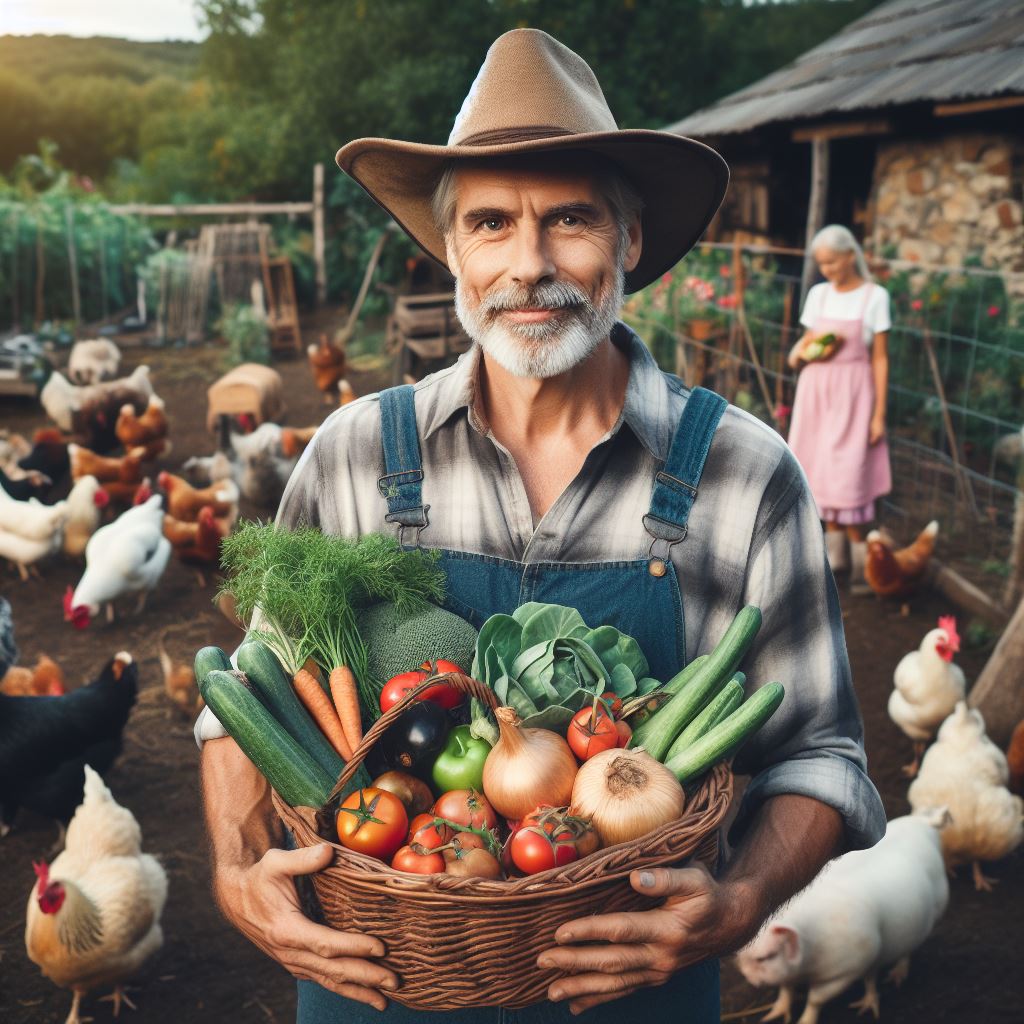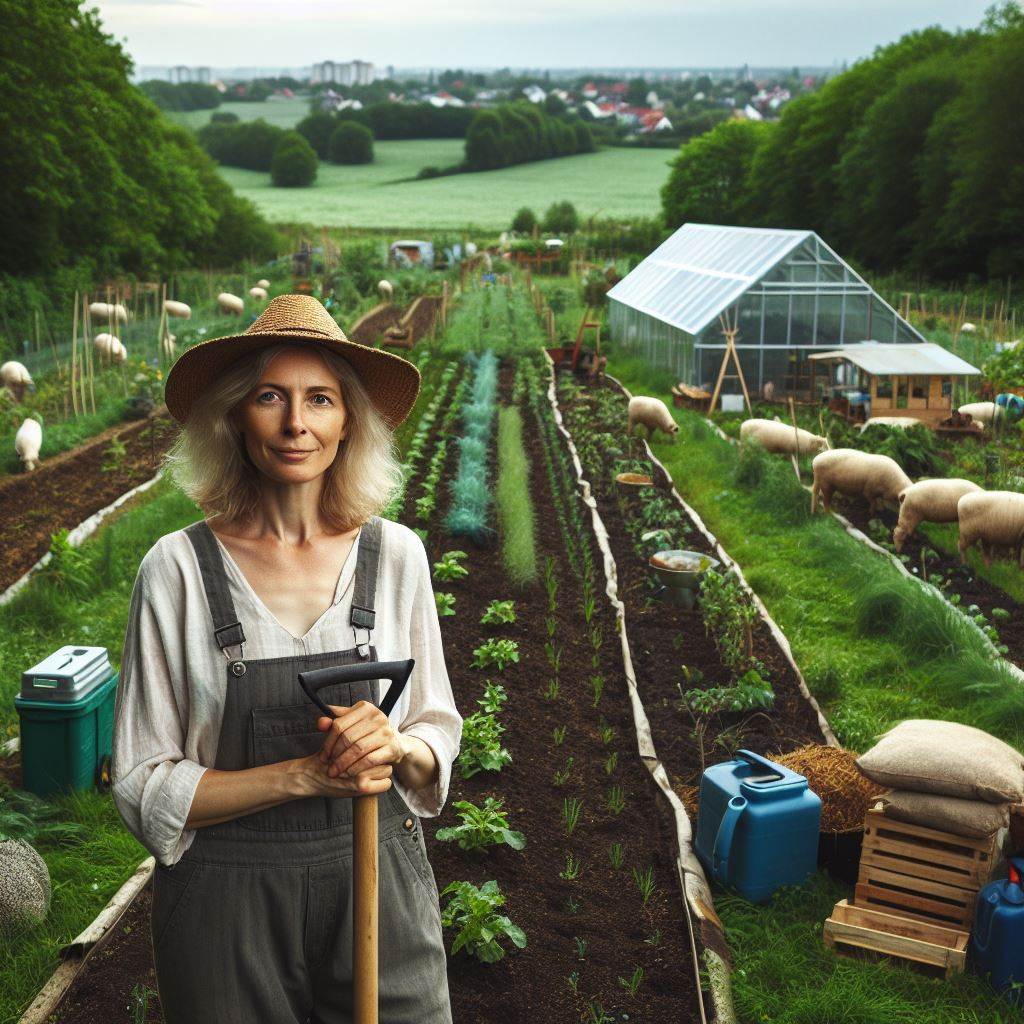Introduction
Permaculture is a holistic design system that focuses on creating sustainable and regenerative ecosystems.
It combines agriculture, horticulture, and social design principles to create a harmonious and productive system.
In farming, permaculture plays a crucial role in promoting ecological balance, conserving resources, and reducing reliance on external inputs.
It encourages farmers to work with nature rather than against it, resulting in healthier soil, increased biodiversity, and improved resilience to climate change.
The key principles of permaculture can be summarized as follows:
- Observing and interacting with the environment to understand its patterns and dynamics.
- Catching and storing energy, such as through the use of solar panels or rainwater harvesting.
- Obtaining a yield by designing systems that provide multiple benefits and outputs.
- Applying self-regulation and accepting feedback to continually improve the system.
- Using and valuing renewable resources and services to reduce waste and dependency on non-renewable resources.
- Producing no waste by reusing, recycling, and repurposing materials within the system.
- Designing from patterns to details, considering the overall structure and function before making specific design choices.
- Integrating rather than segregating elements to create beneficial relationships and efficient exchanges.
- Using small and slow solutions to address problems gradually and effectively.
- Valuing and cultivating diversity, both in terms of species and human interactions, to enhance resilience and adaptability.
By understanding and applying these key principles, farmers can transform their practices to be more sustainable, productive, and resilient.
Permaculture offers a framework for creating regenerative systems that benefit both people and the planet.
Principle 1: Observe and Interact
A. Explanation of the first principle
- Observing and interacting is a fundamental principle in permaculture farming.
- It involves carefully observing the land, the environment, and the patterns of nature.
- By observing, farmers can gain a deeper understanding of their surroundings and make informed decisions.
- Interacting refers to actively engaging with the land, plants, and animals through hands-on practices.
- This principle emphasizes the importance of being present and responsive to the needs of the ecosystem.
- It encourages farmers to actively participate in the natural processes and cycles of the farm.
B. Examples of how farmers can implement this principle
- Take the time to study and understand the local climate, weather patterns, and seasons.
- Observe the existing flora and fauna on the farm to determine how they interact with each other.
- Conduct soil tests to analyze the composition and fertility of the land.
- Use methods like contour mapping to understand the water flow and design appropriate irrigation systems.
- Regularly walk through the farm, pay attention to any changes or issues, and take necessary actions.
C. Benefits of observing and interacting in permaculture farming
- Improved decision-making: By closely observing and interacting with the farm, farmers can make more informed choices regarding land management.
- Better understanding of ecosystems: This principle helps farmers gain a deeper knowledge of the complex interactions within the farm’s ecosystem.
- Enhanced productivity and resilience: By closely monitoring the land and interacting with it, farmers can identify and address any issues or challenges promptly, leading to improved productivity and resilience.
- Reduced reliance on external inputs: Through observation and interaction, farmers can identify natural resources within the farm that can be utilized, reducing the need for external inputs.
- Environmental and ecological awareness: This principle fosters a connection with nature and a greater appreciation for the environment, leading to more sustainable farming practices.
- Increased adaptability: By observing and adapting to the changing conditions of the farm, farmers can respond effectively to climate variations and other uncertainties.
In short, the first principle of permaculture farming, observe and interact, emphasizes the importance of actively engaging with the land, environment, and natural processes.
By carefully observing and interacting with the farm, farmers can make informed decisions, better understand ecosystems, and enhance productivity while practicing sustainable farming methods.
Principle 2: Catch and Store Energy
In permaculture, the second principle emphasizes the importance of catching and storing energy within a system.
One way to catch energy is by utilizing natural resources such as sunlight, wind, and rain. These elements can be harnessed and stored for later use.
Another way to store energy is by using various techniques like rainwater harvesting, composting, and creating food forests.
By implementing this principle on a farm, there are numerous advantages that can be achieved:
A. Explanation of the Second Principle
The second permaculture principle, catch and store energy, focuses on the significance of capturing and conserving resources within the system.
It seeks to create a self-sustaining environment that minimizes external inputs and maximizes efficiency.
Transform Your Agribusiness
Unlock your farm's potential with expert advice tailored to your needs. Get actionable steps that drive real results.
Get StartedEnergy can be understood as anything that has the ability to do work. In permaculture, energy sources include sunlight, wind, water, biomass, and even human effort.
The principle revolves around harnessing these sources and storing them for future use.
The key idea behind this principle is to reduce waste and create resilient systems that can meet their energy needs without relying heavily on non-renewable resources.
It helps reduce the ecological footprint, increase self-reliance, and maintain a long-term sustainable system.
B. Ways to Catch and Store Energy in a Permaculture System
- Sunlight: Design the layout of your farm to maximize exposure to sunlight. Utilize solar panels to capture and store solar energy for electricity needs.
- Wind: Install wind turbines to convert wind energy into electricity. Use windbreaks and strategic planting to create microclimates and optimize energy efficiency.
- Rainwater Harvesting: Collect rainwater through various methods like rain barrels, swales, and ponds. Store this water for irrigation, livestock watering, and other agricultural needs.
- Biomass: Create compost piles to convert organic waste into nutrient-rich soil amendments. Utilize biomass energy through anaerobic digestion to generate biogas for cooking and heating.
- Food Forests: Establish diverse food forests that mimic natural ecosystems. These forests not only provide food but also store solar energy through photosynthesis.
C. Advantages of Utilizing this Principle on a Farm
- Energy Independence: By capturing and storing energy on-farm, the reliance on external energy sources decreases, resulting in increased autonomy.
- Cost Savings: Utilizing renewable energy sources can lead to significant cost savings in the long run. It reduces reliance on expensive fossil fuels and grid electricity.
- Increased Sustainability: By minimizing reliance on non-renewable resources and reducing waste, farming systems become more sustainable and environmentally friendly.
- Resilience to Climate Change: Catching and storing energy reduces the vulnerability of a farm to external factors like power outages, fuel shortages, and extreme weather events.
- Regenerative Agriculture: Implementing this principle fosters regenerative practices by harnessing resources in a way that supports the natural ecosystem, improving soil fertility, and overall farm health.
By incorporating the catch and store energy principle, permaculture systems can become self-sustaining, resilient, and ecologically balanced, providing a model for sustainable farming practices.
Read: Farming and Solar: A Perfect Match
Principle 3: Obtain a Yield
A. Explanation of the third principle
The third principle of permaculture emphasizes the importance of obtaining a yield from our actions and designs.
In permaculture, it is essential to create systems that provide us with tangible and beneficial outputs.
B. Examples of different yields in permaculture farming
- Food: One of the most obvious and important yields in permaculture farming is the abundant production of high-quality, nutrient-rich food.
By designing systems that maximize productivity, we can obtain a variety of crops for sustenance. - Medicine: Another valuable yield in permaculture farming is the cultivation of medicinal plants. Growing herbs and plants with healing properties not only benefits our health but also reduces our reliance on synthetic drugs.
- Fiber: Permaculture farming methods can also yield natural fibers for clothing and other textile purposes. By growing plants like cotton, flax, or hemp, we can create sustainable alternatives to synthetic fabrics.
- Fuel: Permaculture design emphasizes the use of renewable energy sources. Obtaining a yield of biomass for fuel, such as firewood or biogas, reduces our reliance on non-renewable energy and minimizes environmental impact.
- Wildlife Habitat: Creating diverse ecosystems through permaculture practices yields a variety of habitats for wildlife. These habitats support the conservation of biodiversity and help maintain a balance in the natural ecosystem.
C. Importance of obtaining a variety of yields
Obtaining a variety of yields is crucial in permaculture farming for several reasons:
- Resilience: By obtaining multiple yields, a permaculture system becomes more resilient to disruptions. If one yield fails, the system can still provide other resources, ensuring the overall sustainability of the design.
- Economic Viability: Having diverse yields allows permaculture farmers to generate income from various sources. This reduces dependence on a single crop and provides financial stability even in fluctuating market conditions.
- Nutrient Cycling: Different yields contribute to the cycle of nutrients in a permaculture system. For example, food scraps can be composted to enrich the soil, which in turn improves the yield of other crops.
- Human Satisfaction: Obtaining a variety of yields provides a sense of abundance and fulfillment. Knowing that our efforts produce multiple outputs brings satisfaction and reinforces our connection to nature.
- Environmental Sustainability: By obtaining diverse yields, permaculture farming promotes environmental sustainability.
It reduces monoculture and reliance on chemical inputs while creating balanced ecosystems that support long-term ecological health.
In fact, obtaining a yield is a central principle in permaculture farming.
By focusing on diverse and beneficial outputs, we can create resilient, economically viable, and environmentally sustainable systems that nourish both people and the planet.
Read: Biomass Use in Eco-Agriculture
Principle 4: Apply Self-Regulation and Accept Feedback
A. Explanation of the fourth principle
Permaculture is a system of agricultural and social design principles centered around simulating or directly utilizing the patterns and features observed in natural ecosystems.
One of these principles, Principle 4, is to Apply Self-Regulation and Accept Feedback.
This principle emphasizes the importance of self-regulation in managing and maintaining a permaculture system.
It involves taking responsibility for our actions, making informed choices, and being aware of the potential impacts on the system as a whole.
B. Methods to achieve self-regulation in permaculture
To achieve self-regulation in permaculture, several methods can be employed:
- Designing systems with built-in checks and balances to prevent excessive use of resources.
- Implementing appropriate boundaries and limits to ensure sustainability and avoid overexploitation.
- Adopting monitoring and observation practices to assess the health and functioning of the system.
- Using planning and goal-setting techniques to guide decision-making and prioritize actions.
- Engaging in ongoing education and learning to enhance knowledge and understanding of the system.
These methods play a crucial role in maintaining the balance of a permaculture system and minimizing negative impacts on the environment.
C. The role of feedback in improving a permaculture system
Feedback, both internal and external, plays a significant role in improving a permaculture system.
It provides valuable information and insights that can be used to make adjustments and refine the system’s design and management.
Internal feedback involves self-reflection and self-assessment. By observing and reflecting on the outcomes of our actions, we can identify areas for improvement and make necessary changes accordingly.
This self-feedback loop encourages continuous learning and adaptation.
External feedback is obtained from other individuals, communities, and the environment. It can be in the form of advice, suggestions, or observations.
This feedback helps us gain different perspectives and insights, enabling us to refine our practices and make the necessary adjustments to enhance the system’s overall functioning.
Showcase Your Farming Business
Publish your professional farming services profile on our blog for a one-time fee of $200 and reach a dedicated audience of farmers and agribusiness owners.
Publish Your ProfileA permaculture system that embraces feedback is more likely to be dynamic, resilient, and adaptable.
By actively seeking feedback and taking it into serious consideration, we can foster a culture of continuous improvement and refine the design and management of the system.
Feedback also plays a crucial role in building strong communities and fostering collaboration within the permaculture movement.
Sharing knowledge, experiences, and ideas through feedback helps create a supportive and learning-oriented environment where practitioners can collectively strive for improvement.
To conclude, Principle 4 of permaculture emphasizes the importance of self-regulation and feedback in designing and managing sustainable systems.
By applying self-regulation techniques and actively seeking feedback, we can continuously improve our practices, enhance the system’s resilience, and build a healthier and more vibrant environment.
Read: Harness Wind: Sustainable Farming
Principle 5: Use and Value Renewable Resources and Services
A. Explanation of the fifth principle
Permaculture encourages the utilization and appreciation of renewable resources and services.
These resources have the ability to replenish themselves over time, ensuring a sustainable and resilient system.
By incorporating renewable resources and services into our designs and practices, we can minimize our dependence on non-renewable sources and reduce our ecological footprint.
B. Examples of renewable resources and services in permaculture
- Sunlight: The sun is an abundant and infinitely renewable resource. Permaculture emphasizes harnessing solar energy through passive solar design, solar panels, and solar heating systems.
- Rainwater: Rainwater harvesting is a common practice in permaculture. By collecting rainwater in tanks or swales, we can use it for irrigation and reduce our reliance on freshwater sources.
- Wind energy: Wind turbines provide a clean, renewable source of electricity. Permaculture incorporates wind energy systems to power homes, farms, and other structures.
- Biomass: Unlike fossil fuels, biomass is a renewable energy source derived from organic matter. Permaculture promotes the use of biomass for heating, cooking, and electricity production.
- Nutrient cycling: Permaculture systems focus on recycling and reusing nutrients to sustain soil fertility. Composting, vermiculture, and cover cropping are examples of practices that enhance nutrient cycling.
- Pollinators: Bees, butterflies, birds, and other pollinators play a vital role in sustaining plant diversity. Permaculture emphasizes providing habitat and resources to support healthy populations of pollinators.
C. Importance of prioritizing their use and value
- Environmental sustainability: Utilizing renewable resources and services allows us to reduce our impact on the environment. It promotes a balanced and harmonious relationship with nature, ensuring the long-term health and resilience of ecosystems.
- Energy independence: By relying on renewable energy sources, we can become less dependent on fossil fuels and the volatile energy market. This enhances our energy security and reduces greenhouse gas emissions.
- Economic benefits: Investing in renewable resources and services can lead to cost savings in the long run. By minimizing energy consumption and utilizing free resources like sunlight and rainwater, we can lower our utility bills and increase financial stability.
- Community resilience: Building a permaculture system that prioritizes renewable resources and services fosters community self-reliance. It encourages local production, reduces vulnerability to energy price fluctuations, and strengthens community bonds through shared knowledge and resources.
In general, Principle 5 of permaculture emphasizes the importance of using and valuing renewable resources and services.
By incorporating sustainable practices and technologies that harness the power of nature, we can create resilient systems that benefit both the environment and the community.
Prioritizing renewable resources not only mitigates climate change but also ensures a more sustainable and harmonious future.
Read: Wind Farms in Agriculture: A Guide

Principle 6: Produce No Waste
A. Explanation of the sixth principle
In permaculture, the principle of producing no waste is based on the idea that every resource has a purpose and can be utilized efficiently.
This principle encourages individuals to design systems that aim to minimize waste and maximize the use of available resources.
By avoiding the generation of waste, permaculture promotes sustainable practices and creates a more harmonious relationship with the environment.
B. Strategies for reducing waste in permaculture farming
- Composting: Utilizing organic waste materials to create nutrient-rich compost for the soil.
- Implementing recycling systems for plastic, glass, and metal containers.
- Using natural pest control methods to reduce the need for chemical pesticides.
- Integrating livestock into the system to utilize waste products and convert them into valuable resources.
- Implementing water conservation techniques such as rainwater harvesting and drip irrigation.
C. Benefits of minimizing waste in a permaculture system
- Resource efficiency: By utilizing resources fully and minimizing waste, permaculture systems make the most of available resources.
- Environmental sustainability: Reducing waste helps to preserve natural resources and minimize the impact on ecosystems.
- Cost-effectiveness: Minimizing waste can lower input costs by reducing the need for external inputs and resources.
- Soil health improvement: Composting organic waste materials improves soil fertility and structure, benefiting plant growth.
- Biodiversity promotion: Integrating waste products into the system encourages diverse habitats and supports various organisms.
- Resilience: Permaculture systems with reduced waste have increased resilience to external shocks and disturbances.
Minimizing waste in permaculture farming is a holistic approach that aligns with the principles of sustainability and efficiency.
By recognizing the value in every resource and designing systems that optimize their use, permaculturists contribute to a more sustainable and resilient future for our planet.
Implementing strategies like composting, recycling, and water conservation minimizes waste, preserves natural resources, and enhances overall system productivity.
Through the principle of producing no waste, permaculture demonstrates its ability to create regenerative systems that offer long-term benefits for both the environment and humanity.
Principle 7: Design from Patterns to Details
A. Explanation of the seventh principle
Designing from patterns to details is a key principle in permaculture that emphasizes the importance of observing and understanding patterns in the natural world.
By carefully observing patterns, we can gain insight into the relationships and connections between elements in nature.
B. How to apply this principle in permaculture design
When applying this principle in permaculture design, it is essential to start by observing the existing patterns in the landscape.
This can include studying weather patterns, wildlife movement, water flow, and even the growth patterns of plants.
By understanding these patterns, we can then design our systems to work in harmony with them.
For example, if we observe that the water tends to accumulate in a certain area of the landscape during heavy rainfall, we can design our water catchment systems and swales to collect and store that water.
By designing our systems based on the existing patterns, we optimize their efficiency and minimize the need for external inputs.
C. Advantages of designing from patterns
Designing from patterns offers several advantages in permaculture. Firstly, it allows us to harness the inherent efficiency and resilience of natural systems.
By mimicking natural patterns, we can create designs that are self-regulating and sustainable.
Secondly, designing from patterns helps us avoid costly and unnecessary mistakes.
By observing and understanding the patterns, we can identify potential problems and challenges before implementing our designs.
This saves us time, money, and resources in the long run.
Furthermore, designing from patterns promotes biodiversity and ecological balance. By studying the patterns in an ecosystem, we can identify the roles and functions of different elements.
This knowledge allows us to create designs that support a diverse range of plants, animals, and microorganisms, fostering a balanced and thriving ecosystem.
In permaculture, designing from patterns also encourages creativity and innovation.
By observing and understanding patterns, we can develop unique and effective design solutions that integrate seamlessly with the surrounding environment.
To summarize, designing from patterns to details in permaculture is a powerful approach that allows us to create sustainable and harmonious designs.
By observing and understanding the patterns in nature, we can optimize our designs, minimize mistakes, promote biodiversity, and encourage creativity.
It is a principle that reminds us to work with nature rather than against it, leading to resilient and regenerative systems.
Showcase Your Farming Business
Publish your professional farming services profile on our blog for a one-time fee of $200 and reach a dedicated audience of farmers and agribusiness owners.
Publish Your ProfilePrinciple 8: Integrate Rather Than Segregate
A. Explanation of the eighth principle
In permaculture, the principle of integration emphasizes the importance of connecting and intermingling elements within a system rather than keeping them separate.
It promotes the idea that everything is connected and functions harmoniously when integrated.
B. Examples of integration in permaculture farming
- Polycultures: Instead of planting monocultures, permaculture advocates for planting a diverse range of plants together.
This helps create a balanced ecosystem, where each plant serves a unique purpose and supports the growth of others. - Companion planting: Certain plants have natural affinities for each other and can benefit when grown together.
For example, planting marigolds with tomatoes can help repel pests and improve the overall health of the tomato plants. - Animal integration: Integrating animals into permaculture systems can provide multiple benefits.
Chickens, for instance, can help control pests, fertilize the soil with their droppings, and even assist with weed removal.
C. Benefits of integrating elements in a permaculture system
- Enhanced biodiversity: By integrating different plants and animals, permaculture systems increase biodiversity, which is crucial for the overall resilience and productivity of the system.
- Nutrient cycling: Integration allows for efficient nutrient cycling within the system. For example, plant residues can be used as mulch or compost, providing organic matter for soil fertility.
- Pest and disease control: The integration of various elements can help naturally control pests and diseases.
For instance, by attracting beneficial insects, such as ladybugs, to the garden, pest populations can be reduced without the need for harmful pesticides. - Reduced waste: Integration enables the use of waste from one element to benefit another. For instance, wastewater from a kitchen can be treated and used to irrigate plants, conserving water resources and closing the nutrient loop.
- Increased resilience: Integrated systems are more resilient to environmental changes and disturbances.
The diverse elements provide multiple functions and resources, ensuring that even if one component fails, the system as a whole can still thrive.
The eighth permaculture principle emphasizes the importance of integration to create sustainable and productive systems.
By interconnecting elements in a permaculture system, we can harness the power of synergies and mimic natural patterns, resulting in more resilient and regenerative designs.
Principle 9: Use Small and Slow Solutions
A. Explanation of the ninth principle
The ninth principle of permaculture emphasizes the importance of embracing small and slow solutions.
Rather than implementing large, rapid changes, permaculture encourages a more gradual and sustainable approach.
By focusing on small and slow solutions, permaculturists aim to create resilient systems that can adapt and evolve over time.
This principle recognizes that change takes time and that it is essential to observe and understand the dynamics of a system before making any significant interventions.
Small and slow solutions allow for easy monitoring and adjustments, minimizing the potential risks and negative impacts that can arise from large-scale interventions.
B. How to implement small and slow solutions in permaculture
Implementing small and slow solutions in permaculture involves several key strategies:
- Start small: Begin with small-scale projects that are manageable and allow for experimentation.
- Observe and interact: Take the time to observe and understand the patterns and dynamics of the system before making any changes.
- Gradual implementation: Implement changes gradually, allowing the system to adapt and respond naturally.
- Feedback loops: Continuously monitor and assess the impacts of your interventions, making adjustments as necessary.
- Use feedback as a learning tool: Embrace failures and successes as learning opportunities, refining your approach over time.
- Build upon success: Once small-scale solutions have proven successful, scale them up gradually.
C. Advantages of focusing on small-scale changes
Emphasizing small and slow solutions in permaculture offers several advantages:
- Reduced risk: Small-scale changes are less likely to disrupt the existing system and have minimal negative consequences.
- Lower cost and effort: Small projects are generally more affordable and manageable, requiring less initial investment.
- Increased flexibility: Small-scale solutions allow for easy adjustments and adaptations as new information or challenges arise.
- Improved learning: The gradual approach provides a valuable learning experience, allowing for a deeper understanding of the system.
- Greater community involvement: Small and slow solutions encourage community engagement and participation, fostering a sense of ownership and collaboration.
- Long-term sustainability: By focusing on small-scale changes, permaculture promotes long-term system resilience and stability.
In a nutshell, Principle 9 of permaculture highlights the significance of utilizing small and slow solutions in creating sustainable and resilient systems.
By starting small, observing and interacting, implementing changes gradually, and learning from feedback, permaculturists can achieve long-term success in creating harmonious relationships with nature.
Principle 10: Use and Value Diversity
A. Explanation of the tenth principle
Diversity is crucial in permaculture farming as it enhances resilience and stability within the ecosystem.
The tenth principle emphasizes the importance of utilizing various elements in a permaculture system.
By incorporating diversity, we can mimic natural ecosystems, which are abundant with different species and interactions.
B. Ways to incorporate diversity in permaculture farming
- Plant polycultures: Instead of mono-cropping, plant a mix of different crops in the same area.
- Introduce beneficial insects: Encourage the presence of beneficial insects that prey on pests.
- Create habitat diversity: Install diverse structures, like hedgerows or ponds, to encourage a variety of organisms.
- Implement companion planting: Pair plants that benefit each other, such as marigolds deterring pests from vegetables.
- Incorporate livestock: Animals can contribute to nutrient cycling, enhance soil health, and diversify income opportunities.
C. Importance of valuing and maintaining diversity in a permaculture system
- Resilience and stability: A diverse ecosystem is better equipped to withstand fluctuations and disturbances.
- Pest and disease management: By incorporating diversity, we can naturally control pests and reduce the risk of epidemics.
- Increased productivity: Different species perform various functions, resulting in improved overall productivity.
- Nutrient cycling: Diversity enhances nutrient cycling, reducing the need for external inputs.
- Ecosystem services: Diverse systems provide a wide range of services like pollination and soil fertility.
- Climate resilience: A diverse system can adapt to changing climate conditions, enhancing its long-term sustainability.
- Cultural significance: Diversity celebrates and respects different cultures, traditions, and knowledge systems.
- Economic benefits: Diverse systems foster multiple income streams and provide opportunities for niche markets.
D. Examples of diversity in a permaculture system
- Polyculture: Growing tomatoes, beans, and basil together, maximizing space and symbiotic relationships.
- Incorporating livestock: Integrating chickens, ducks, or goats into the system for eggs, meat, and manure.
- Creating habitat diversity: Installing beehives, birdhouses, or ponds to attract beneficial pollinators and predators.
- Companion planting: Planting carrots and onions together to repel pests and improve soil health.
- Mushroom cultivation: Growing oyster mushrooms on logs to improve soil structure and diversify food production.
In summary, diversity is a key principle in permaculture farming as it enhances the resilience, stability, and productivity of the system.
By incorporating various elements, we can mimic the complexity and interconnections found in natural ecosystems.
Valuing and maintaining diversity not only benefits the environment but also provides economic opportunities and cultural significance.
Embracing diversity in permaculture systems is essential for creating sustainable and regenerative practices.
Conclusion
A. Recap of Permaculture Principles
Let’s revisit the core permaculture principles: observe and interact, catch and store energy, obtain a yield, apply self-regulation, and accept feedback.
B. Importance of Permaculture in Sustainable Farming
Permaculture ensures sustainable farming by fostering biodiversity, improving soil health, and promoting ecological harmony.
Its holistic approach minimizes environmental impact and maximizes long-term productivity.
C. Encouragement for Further Exploration
- Dive deeper: Explore advanced permaculture techniques like guild planting and keyline design.
- Community involvement: Share permaculture knowledge with local farmers, fostering a collective commitment to sustainability.
- Continuous learning: Attend workshops, join forums, and stay updated on evolving permaculture practices.
- Implement gradually: Start small, integrating permaculture principles step by step into your farming practices.
In the end, embracing permaculture isn’t just a choice; it’s a commitment to a greener, more sustainable future.
So, let’s cultivate change together!




